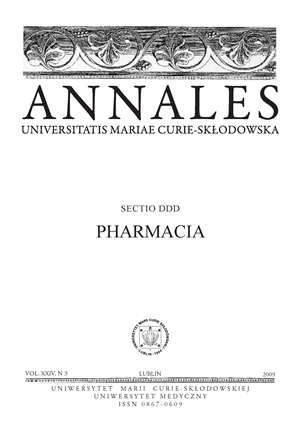Wpływ inhibitora COX-2 celekoksybu i blokera pompy protonowej lansoprazolu na procesylipoperoksydacji w sercu i śluzówce żołądka szczurów z cukrzycą indukowaną streptozotocyną
Abstrakt
Badano wpływ inhibitora COX-2 celekoksybu i blokera pompy protonowej lansoprazolu na lipoperoksydację, obronę antyoksydacyjną i zawartość tlenku azotu w śluzówce żołądka i sercu szczurów z cukrzycą streptozotocynową. Uzyskane wyniki wskazują na aktywację procesów lipoperoksydacji i wzrost aktywności enzymów ochrony antyoksydacyjnej. Hamowanie syntezy prostaglandyn przez COX-2 zmniejszało stres oksydacyjny w obydwu badanych tkankach. Blokada pompy protonowej prowadziła do znacznego wzrostu zawartości NO w sercu i spadku zawartości MDA w śluzówce żołądka.
Bibliografia
1. Basu S., Larsson A., Vessby J. et. al. Type 1 Diabetes Is Associated With Increased Cyclooxygenase- and Cytokine-Mediated Inflammation. Diabetes Care, 28, 1371, 2005.
2. Chaiamnuay S., Allison J. J., Cur t is J. R.: Risks versus benefits of cyclooxygenase-2-selective nonsteroidal anti-inflammatory drugs. American Journal of HEALTH-System Pharmacy, 63 (19), 1837, 2006.
3. FedorchenkoIu L.: Status of intragastric acidity in diabetes mellitus patients with chronić gastroduodenal ulcers. Exp. Klin. Gastroenterol, (6), 26, 2002.
4. Fomenko I., Bondarchuk T., Sklyarov A.: The relationship between action of proton pump inhibitors and COX-inhibitors on oxidative stress in stomach and heart tissue: Gut. An International Journal of Gastroenterology and Hepatology, 39 (1), 231, 2007.
5. Koroluk M. A. et al.: A method for measuring catalase activity. Laboratornoje Delo, 1, 16, 1988.
6. Lyall F. et al.: Nitric oxide concentration are increased in the fetoplacental circulation in preeclampsia. Am. J. Obstet. Gynecol., 173: 714 , 1995.
7. Maritim A.C., Sanders R. A., Watkins J. B.: 3rd. Diabetes, oxidative stress, and antioxidants: a review. J. Biochem. Mol. Toxicol.: 17(1), 24, 2003.
8. Sandstrom J., Nilsson P., Karlsson R. et al.: 10-Told increase in human plasma extracellular superoxide dismutase content caused by amutation in heparin-binding domain. J. Biol. Chem., 269, 29, 19163, 1994.
9. Schildrkneht S., Bachscmid M., Bauman A., Ullrich V.: COX-2 inhibitors selectively blok prostacyclin synthesis in endotoxin-exposed vascular smooth muscle cells. The FASEBJ., 1, 757, 2004.
10. Timirbulatov R. A.: Method for increasing intensity of free radical oxydation of blood lipid containing components and its diagnostic. Laboratornoje Delo, 4, 209, 1981.
11. Traub O., Van Bibber R.: Role of nitric oxide in insulin-dependent diabetes mellitus-related vascular complications. West J. Med., 162(5), 439, 1995.
12. Vincent A. M., Russel J. W., Low Ph., Feldman E. L.: Oxidative Stress in the Pathogenesis of Diabetic Neuropathy. Endocrine Reviews, 25(4), 612, 2004.
Pobrania
Opublikowane
Numer
Dział
Licencja
Prawa autorskie (c) 2009 Autorzy

Praca jest udostępniana na licencji Creative Commons Attribution-NonCommercial-NoDerivatives 3.0 Unported License.


